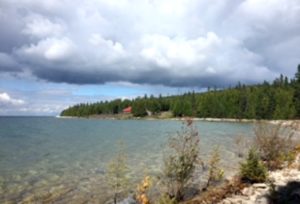Walking the Anishinabek Nation towards an active lifestyle one step at a time

By Laura Barrios
NIPISSING FIRST NATION—The Union of Ontario Indians Anishinabek Nation Diabetes Education Program sponsored the inaugural Walk the Anishinabek Nation challenge which took place from September 1 to October 31, with 430 Anishinabek citizens participating.
The overall goal of the challenge was simply to get the Anishinabek Nation citizens active, and to promote the benefits of staying active. Walking can help reduce the risk of diabetes, heart disease, and strengthen bones and muscles, to name a few benefits.
“I found this one hour of walking daily does my memory [well],” stated Raymond Tabobondung, a 71-year-old participant from Wasauksing First Nation. “I get to think of my daily to-do’s and not-to-do’s, and to refresh my thoughts on other projects that I could be doing, and able to meaningfully.”
Anishinabek Nation citizens of all ages were encouraged to participate in this challenge. Pedometers, reflective arm bands, and calendars were provided to all participants to assist in keeping track of how many steps were taken each day of the challenge.
Some participants would provide weekly reports or check-ins to document progress of steps taken. Other participants would submit in-action photographs or shots of the scenic views during their routine walk.
“I have lost five pounds and my blood pressure is better,” reported Larry Whetung, participant from Curve Lake First Nation. “[The Walk the Anishinabek Nation challenge challenged] us to be more active and more conscious of our health needs.”
As the challenge concluded, some participants expressed that they were going to continue staying active.
“I have a lot more respect of being mindful of watching my exercise routine and really watching my steps,” wrote Stacy Gionet, citizen from Beausoleil First Nation and participant in the challenge. “This was a neat two-month challenge; I plan to keep up.”
Some participants mentioned that they have joined or will join a gym over the cold winter months to maintain the active regimen momentum.
“I’ve got a gym membership [that] I’ll be using for the winter months,” stated Charlene Sagon-Panamick, a participant from Zhiibaahaasing First Nation. “I’ve gotten used to walking and getting exercise everyday…It was awesome to take part in this walking challenge. It gave me something to keep me on track with my walking.”
Aside from feeling healthier, participants shared how they have physically changed by losing inches or weight during the course of the two-month challenge. Based on the overwhelming positive feedback from the participants during and following the challenge, the Walk the Anishinabek Nation challenge has proven to have had a very positive impact on the Anishinabek Nation.
“My husband…and I just completed the two month Walk the Anishinabek Nation [challenge] as participants from Wasauksing First Nation community,” wrote Doris Potts-Zyganiuk of Wasauksing First Nation. “Was that ever wonderful! It had its challenges, but overall, it was motivating!”
After all of the calendars from the participants were received and tallied, a remarkable cumulative 42,957,694 steps (which is equivalent to 32,544km) were reportedly taken. It takes approximately 5,378,736 steps (which is equivalent to 4,075km) to walk the Anishinabek Nation. Altogether, the over 400 participants walked the nation almost eight times over.
As the challenge was based on steps taken, prizes were awarded to those who took most steps in various categories. Prizes were awarded to the participants who took the most steps in each of the following three categories: Male, Female, and Children (under 14 years of age).
Each participant received a ballot for every 500 steps taken that went into a draw for a chance to win one of 15 gift cards. All winners have been notified.
The Union of Ontario Indians Health Department Community Health Programs Coordinator, Stephanie Peplinskie, will be conducting the second annual Walk the Anishinabek Nation challenge in 2017.
“I’m very pleased with the initial response and hope to build on that response for next year’s challenge,” stated Peplinskie. “The hope is to generate double the participation or more than this year’s challenge!”
For more details, please visit: http://www.anishinabek.ca/event/walk-the-anishinabek-nation/


